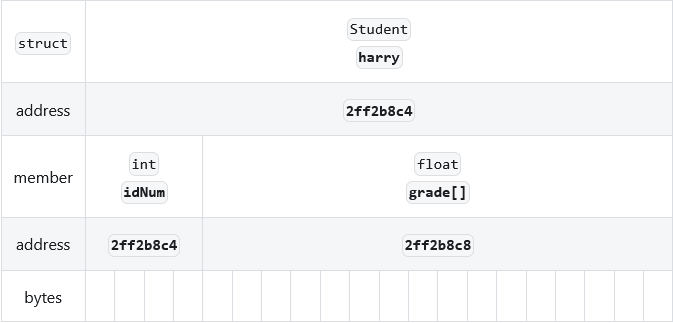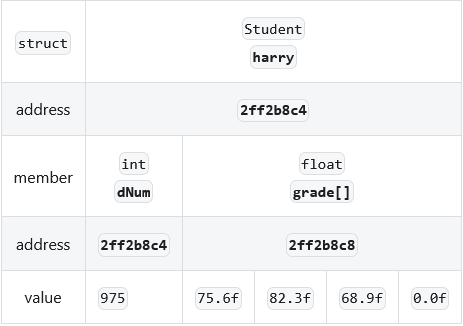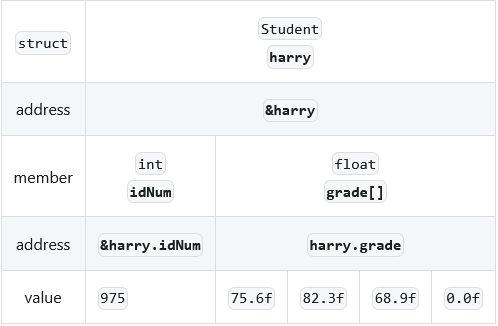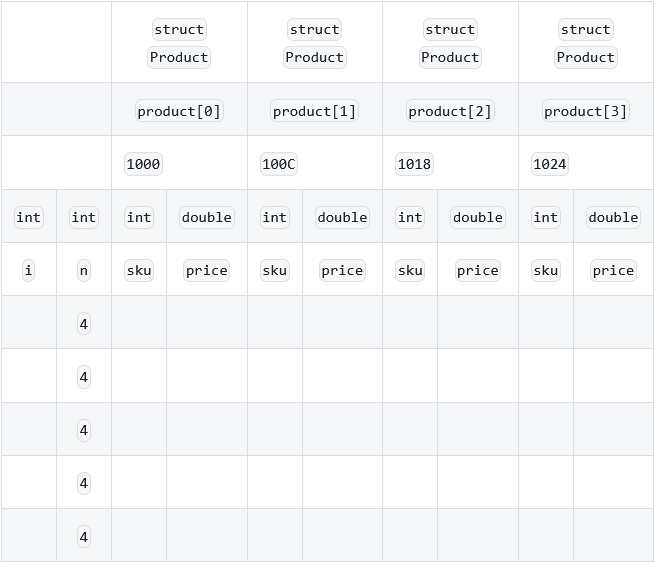Structures
Learning Outcomes
After reading this section, you will be able to:
- Design data collections using structures to manage information efficiently
Introduction
The most commonly used data structure in C language programs aside from the array is the struct or structure. A structure type is a collection of not necessarily identical types. We use the structure type to define a group of variables as a single object.
This chapter reviews the primitive types and presents the syntax for declaring a structure type, defining an object of structure type, and accessing the data values within that object. This chapter includes an example of how to walkthrough a program that includes structure types.
Types
A type describes how to interpret the information stored in a region of memory. In the C language, a type may be a primitive type or a derived type. A derived type is a collection of other types.
Primitive Types
The core language defines the primitive types. We cannot redefine these types or introduce new primitive types. The C language primitive types include:
charintfloatdouble
Each type defines how a value of that type is stored in a region of memory. Consider the int type. A value of int type is stored in equivalent binary representation in 4 bytes on a 32-bit platform:
To define an object of int type called noSubjects, we write:
int noSubjects;
Derived Types
The declaration of a derived type in the C language takes the form
struct Tag
{
//... declarations here
};
where the keyword struct identifies a derived type or structure. Tag is the name by which we call the structure (just like int above). The declaration concludes with a semicolon.
We list the types that belong to the structure along with their identifiers within the curly braces.
struct Tag
{
[type] [identifier];
// ... other types
};
type is the member's type. identifier is the name by which we access the member's value.
Example
Consider a structure type that consists of two pieces of information:
- the student's ID number
- the student's grades (up to 4 individual grades)
Let us call this structure type Student. To declare the type, we write:
struct Student
{
int idNum; // student number
float grade[4]; // grades
};
The members occupy memory in the order in which we have listed them in the declaration of our structure:
This declaration does NOT allocate any memory for any object; it only defines the structure and the rules for objects of that type (in other words, this is NOT a variable declaration).
Declaration
We declare our structure globally and may store its declaration in a separate file called a header file (say, with the name Student.h):
// Student.h
struct Student
{
int idNum; // student number
float grade[4]; // grades
};
When we place source code in a header (.h) file, we insert that header file's code into the source file that requires that information, as shown below. In such cases, our complete source code is stored in more than one file. When compiling multi-file source code, we only pass the .c file(s) to the compiler. The code in a header file is duplicated inside each C file in which it is included, which allows us to write code, like a struct, in one spot and edit it in that one spot alone.
Header files play an important role in modularity and in the organization of code. Header files often contain additional things like macros and function prototypes which will be discussed in the functions topic.
Allocating Memory
When we define an object of a structure, we allocate memory for that object. Our definition takes the form:
struct Tag identifier;
where Tag is the name of the structure and identifier is the name of the object.
Example
To allocate memory for a Student named harry, we write:
// main.c
#include "Student.h" // includes the description of a Student
int main(void)
{
struct Student harry; // allocates memory for harry
// ...
return 0;
}

The object name harry refers to the collection of members in Student harry taken together.
Initialization
To initialize an object of a structure we add a braces-enclosed, comma-separated list of values. We organize the initial values in the same order as the member listing in the declaration of the structure. The initialization takes the form:
struct Tag identifier = { value, ... , value };
Structure initialization is similar to one of an array.
Example
To initialize harry with student number 975 and grades of 75.6, 82.3 and 68.9, we write:
struct Student harry = { 975, { 75.6f, 82.3f, 68.9f } };

Member Access
To access a member of an object of a structure, we use the dot operator (.). Dot notation takes the form:
object.member
To access harry's student number, we write:
harry.idNum
To retrieve the address of a non-array member of an object, we use the address of operator (&):
&instance.member
To access the address of harry's student number, we write:
&harry.idNum
We may omit the parentheses here - &(harry.idNum) - they are unnecessary because the dot (.) operator binds tighter than the address-of operator (see the precedence table).
To access an array member, we refer to its name without brackets. For example, to access the address of harry's grades, we write:
harry.grade
To access an element of an array member, we use subscript notation
object.member[index]
To access harry's third grade, we write:
harry.grade[2]
To retrieve the address of an element of an array member, we use the address of operator (&):
&object.member[index]
To access the address of harry's third grade, we write:
&harry.grade[2]

Example
A convenient alternative to parallel arrays for storing tabular information is an array of structures. One member holds the key, while the other member holds the data.
In the following example, the sku member holds the stock keeping unit (sku) for a product, while price holds its unit price. The header file with the declaration of the Product structure contains:
// Structure Example
// product.h
struct Product
{
int sku;
double price;
};
The program that uses the Product structure is listed below.
// Structure Example
// structure.c
#include <stdio.h>
#include "product.h"
int main(void)
{
int i;
struct Product product[] = { {2156, 2.34}, {4633, 7.89},
{3122, 6.56}, {5611, 9.32} };
const int n = 4;
printf(" SKU Price\n");
for (i = 0; i < n; i++)
{
printf("%5d $%.2lf\n", product[i].sku, product[i].price);
}
return 0;
}
The output produced from the above sample is shown below:
SKU Price
2156 $2.34
4633 $7.89
3122 $6.56
5611 $9.32
Walkthrough
A walkthrough table for a program with structure types includes lists of the member types below the object identifiers. The table for the example above is shown below.
The table includes:
- the structure type of each object
- the identifier of each object
- the type of each member
- the identifier of each member
Each object is broken down into its members in the head of the table. We reserve a separate line for the addresses of the different objects:

Output: